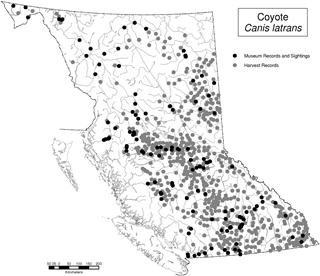The Coyote, or Brush Wolf, looks very much like a medium-sized dog. It is easily recognized by its large ears, big bushy tail and black nose. It is one of two wolf species in British Columbia--the other is the Grey Wolf (
Canis lupus)
The Coyote is found globally in North American and Central America. In North America, it is now found in Alaska and across much of Canada (but not in the far north). However, its range has expanded since settlement times.
Todd and Carbyn (1990) provide more detail on this: "In Canada, the coyote still inhabits its traditional habitats, the aspen parkland and short- and mixed-grass prairie in the three prairie provinces. However, it has spread north into the boreal forest, west into the mountains, and east into Ontario, Quebec, and the Atlantic provinces. The progress of this dramatic "invasion" has been carefully charted; for example, coyotes established themselves in Ontario about the turn of the century, in Quebec in the 1940s, and in New Brunswick and Nova Scotia in the 1970s. Most astonishing of all, coyotes have recently been discovered in western Newfoundland, apparently having crossed on the ice from Nova Scotia."
In British Columbia, coyotes are found throughout the province and are a familiar sight. Often, they can be observed hunting in grassy fields, along forest edges, and along riverbanks, and frequently in urban areas. In Vancouver, it is not unusual to hear coyotes howling at night in Pacific Spirit Park.
Coyotes primarily hunt in pairs although they have been observed in larger groups. They primarily hunt at night to avoid humans but can often be seen during daylight hours foraging in fields and along forest edges. They prey on small mammals, but a pack can bring down larger mammals such as elk (Wikipedia 2011). They also eat fruits and vegetables. In urban areas they prey on pets, and have been known to stake out cat doors.
Denning sites may be located under fallen logs and beneath upturned root balls; they can dig their own burrows, but they will also use groundhog or badger burrows. Litters can have as many a nineteen pups, although six is average (Wikipedia 2011). Coyotes have been known to live up to 10 years in the wild and 18 years in captivity (Wikipedia 2011).
Coyotes are not normally aggressive. However, in 2021, several coyote attacks have been reported in Stanley Park in Vancouver.
